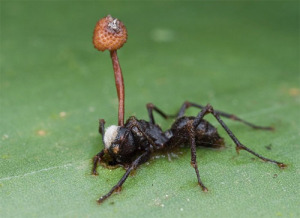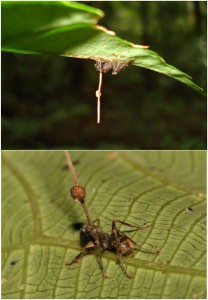
The world of parasites that manipulate the behaviours of their host became even more fascinating this September. A paper published by Charissa de Bekker and colleagues reported findings that begin to unravel the mechanism behind the spectacular ant-brain manipulation performed by a parasitic fungus. The fungus turns its ant hosts into zombies that leave their normal ant trails, climb up, clamp their jaws onto vegetation and die. The fungus then emerges from the ant cadaver to shed spores in the path of foraging ants below.
Fungi in the genus Ophiocordyceps have a pantropical distribution and are known for their ability to manipulate the behaviour of the ants they infect. Ants encounter spores of the fungus whilst foraging in the forest. The fungus secretes enzymes that help it to penetrate through the hard outer skeleton of the ant and grows inside the ant’s body, eventually taking over its nervous system. Infected ants leave their nests in the tree canopy and twitch convulsively until their movements cause them to fall to the ground. In the leaf litter they search for areas within a very specific range of temperature and humidity. Here they climb a stem to reach the underside of a leaf at a particular height from the forest floor and, using their mandibles (jaws), bite into the central vein of a leaf. The muscles of the mandibles then atrophy and the ants go into a state of lockjaw. They cannot release themselves from the bite, which is known as the “bite of death”. At this stage the fungus kills the ant but continues to grow inside the cadaver. Eventually it produces a long tube, its fruiting body, which grows out of the back of the ant’s head and releases spores into the environment. This can be seen in David Attenborough’s brilliant video . The ability of the cordyceps fungus to manipulate the ant into an elevated position is highly adaptive as it gives the spores a better chance of dispersal to areas where they will encounter more ants.
Of these fungi, Ophiocordyceps unilateralis is probably the most studied. It is actually a species complex and four new species in the complex were recently described following collections of carpenter ants made in the rain forests of Minas Gerais, Brazil.

David Hughes and colleagues also published a field study of ants in this area in August this year. They found a low level of infection in all the ant colonies they investigated over a period of 20 months. They mapped in 3D the foraging trails of ants and the location of ant cadavers that they found attached to leaf veins and infected with a different cordyceps species, O. camponoti-rufipedis. Nocturnal observations showed the ant trails persisted for a long time, thus ants would be likely to encounter spores from infected cadavers that had died after climbing vegetation above the trails. By placing infected cadavers inside an ants nest they showed that most of the dead ants were removed by members of the colony, thereby demonstrating a form of social immunity. The fungus could not produce and shed spores effectively when cadavers were placed in an empty nest. Thus, the particular behavioural manipulation that causes ants to stay elevated above the foraging trails rather than return to the nest is necessary for the future transmission of the parasite.
Charissa de Bekker and colleagues are particularly interested in the way in which the fungus performs this manipulation. They have been studying a recently discovered species of the O. unilateralis complex, found in South Carolina, USA. This species causes carpenter ants to die gripping onto the underside of twigs rather than leaves, as do their Brazilian relatives. Their extensive field observations suggested that, of four species of carpenter ant in their study area, only two were found to be naturally infected. They then isolated the fungus from an infected ant’s cadaver and injected it into each of the four species of ants found in their field studies. One of the species that was not naturally infected reacted badly to the injections and died very rapidly. The survival profiles of the injected groups of the other three species were compared with groups of ants that had not been injected, or had been sham injected with a liquid that did not contain the fungal spores. For all three species of ants, those that were infected died more quickly than the uninfected or sham injected ones. However, although a fruiting body was seen to grow out of the back of the two species of ants found to be infected in the field (Camponotus castaneus and Camponotus americanus) no such tube emerged from the third species (Camponotus pennsylvanicus). They did however find fungal spores inside the body of C. pennsylvanicus and concluded that the fungus had killed this species as well. Furthermore, only the two naturally infected species climbed up and bit into the twigs provided in their cage, hanging on with a death bite before they died. This manipulation of their behaviour occurred between 14 and 22 days after they were injected suggesting the fungus needed to grow before it could take control of them. It would seem that the fungus could only manipulate the behaviour of the two naturally infected species.

To determine whether the fungus could distinguish between its natural hosts and a novel ant, and therefore secrete different molecules into the ant, the investigators grew the fungus in culture with the brains from the four different ant species. They collected and analysed the substances secreted by the fungus and also substances secreted by the brains alone, to make sure differences they found where not due to differences in chemicals from the ant brains. The fungus responded to each ant brain differently, secreting a specific set of metabolites in response to each brain type. Seventy three of these were significantly increased in response to C. castaneus alone.
Focusing on C. castaneus, they tried to identify particular molecules secreted by the fungus in response to these ant’s brains. This proved difficult because a database of molecules known to be present in these ants is not complete, however, they did succeed in identifying guanidinobutyric acid as being one compound that the fungus secretes in significantly greater quantities when a C. castaneus brain is present. This molecule is known to be involved in the transport of compounds across the blood-brain barrier and has been involved in convulsions and epileptic discharges in rodents. A putative identification of a sphingosine was also made. Although the research group tried to mimic the action of the fungus on the behaviour of C. castaneus by injecting various dilutions and combinations of these two metabolites into uninfected ants, they were unable to manipulate the ant’s behaviour and concluded that multiple compounds in the fungus secretome are probably involved. This is not surprising as the behavioural changes that the ant exhibits are actually a complex series of behaviours that occur in sequence. They are remarkably reminiscent of behavioural changes induced in shrimps when infected with the immature stages of a spiny headed worm. The shrimps are induced to move to unusual locations and grip vegetation floating on the surface, the muscles of their pincers undergoing a tetanus-like reaction, until accidentally eaten by the next host in the parasite’s life cycle.
Although no particular molecule profile has been shown to be directly responsible for the remarkable change in behaviour that occurs when this particular species of O. unilateralis infects C. castaneus, other candidate compounds may be identified when the fungus secretome is better annotated. Perhaps some of these may even be of interest to the pharmaceuticals industry.
This study of one species of cordyceps fungus demonstrates how specific these interactions can be. The fungus responds differently to chemicals from the brains of different ant species and only some of these brains will stimulate the fungus to produce the chemicals that create zombie ants that aid the fungus to disseminate its spores.

One Comment